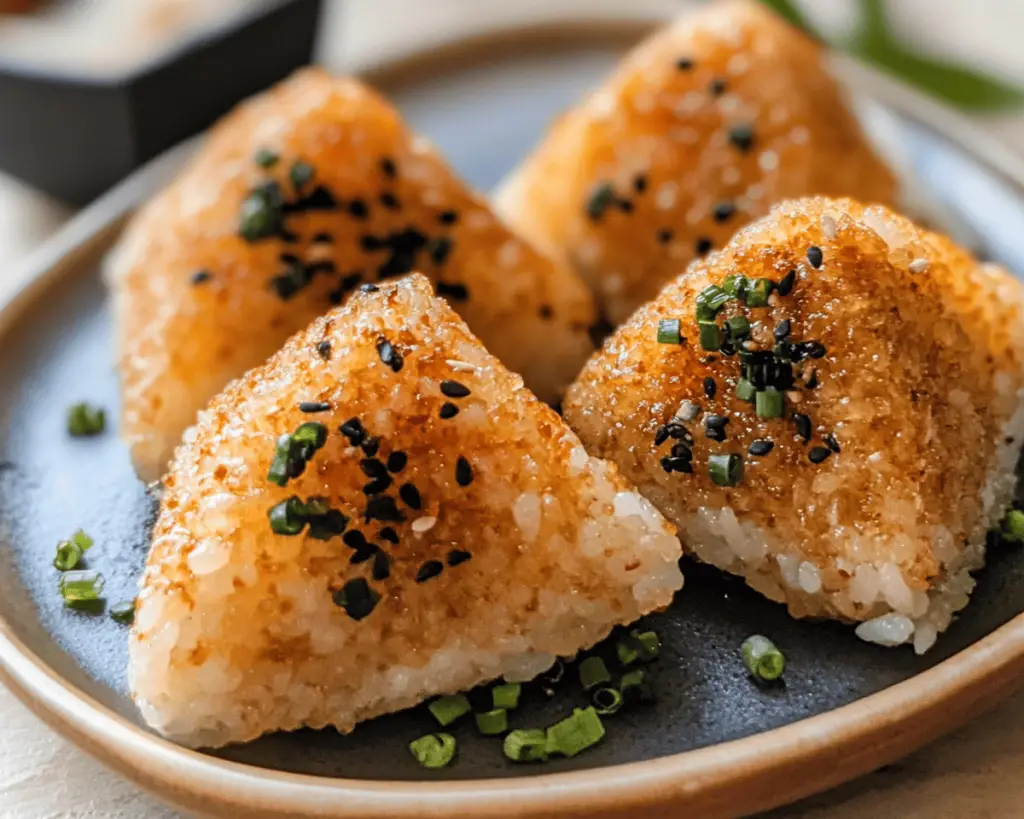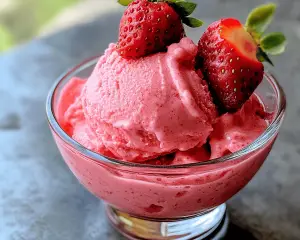The first time I made Crispy Yaki Onigiri was on a brisk autumn afternoon, when the leaves were dancing in shades of amber and crimson, and the world outside felt drenched in the promise of change. It was just a few months after I moved into my first apartment, a tiny space nestled above a bustling bakery that filled the air with the sweet, yeasty scent of fresh bread in the mornings. I remember that day vividly: the sun slanted through the window, and I was overcome with the urge to create something comforting and warm that echoed the rich flavors of my childhood.
Yaki Onigiri is more than just a dish; it’s a bridge to memories, having first experienced it at my grandmother’s house. She was a fierce yet nurturing woman with a kitchen forever bustling. The sound of her rice cooker would signal the start of something good. As a child, I had been fascinated by the simplicity and the essence of the onigiri—rice held together in tender hands, often molded into triangles or balls, and grilled to a satisfying golden crispness. My grandmother would let me dip them in soy sauce before biting into the delicate yet chewy texture. Every bite was a hug, every flavor a reminder of home.
As I prepared to recreate this cherished dish, the scent of rice mingling with the smoky notes of grilled seaweed made me feel grounded and connected. The beauty of Yaki Onigiri lies in its versatility, a canvas for flavors that can tell countless stories, each unique to the person preparing it. Over the years, the recipe evolved for me; sometimes it’s infused with spicy tuna or pickled plum, other times adorned simply with sesame seeds or a dash of shiso leaves. That afternoon, however, I kept it classic, channeling the spirit of my grandmother as I set out to create the perfect crispy exterior and a soft, steamy core.
Inside the Ingredients of Crispy Yaki Onigiri
Let’s delve into the ingredients that make this dish a warm embrace on a plate.
Short-grain Japanese rice: The foundation of Yaki Onigiri, short-grain rice has a higher starch content compared to long-grain varieties, giving it that delightful stickiness that’s essential for shaping. As the rice cooks, it becomes a tender canvas, pliant enough to be molded yet firm enough to hold its structure, making it ideal for onigiri. If you can’t find it, you may substitute it with arborio rice, but the texture won’t be quite the same.
Water: It might seem trivial, but water is key. The purity of the water can affect the taste of your rice, so use filtered if you can. The right amount of water is crucial too; many swear by the finger method—adding water until it reaches the first joint of your index finger above the rice. This simple technique has been passed down through generations and offers a connection to the act of cooking that feels almost spiritual.
Salt: A pinch of salt enhances the flavor of the rice, transforming an ordinary dish into something special. I’ve found that using sea salt adds a subtle mineral quality that elevates the umami flavors of the onigiri.
Nori (seaweed): This adds that crucial crispy element that contrasts beautifully with the warm rice. Toasted nori adds a umami flavor that rounds out the dish. I love the smell of nori gently crisping on the grill; it reminds me of coastal walks and devotion to simplicity.
Soy sauce: A simple drizzle adds depth and a savory edge. Newer iterations of my Yaki Onigiri often include a touch of a sweeter soy sauce, or even some mirin mixed in for added complexity. The salty richness perfectly pairs with the rice.
Fillings: This can transform Yaki Onigiri from classic to adventurous. From spicy tuna, which gives a kick of heat, to pickled plum for a tangy pop, the choice is endless. Each filling carries its own story—spicy tuna on a bake sale, or sweetened fermented plum from that special market down south.
The very act of combining these components is a dance, each ingredient playing its role in the culinary storytelling. The essence of Yaki Onigiri is about balance—the simplest stuff can carry the most meaningful experiences if handled with care.
How Crispy Yaki Onigiri Fits Into a Balanced Life
In our modern world, we often balance the pursuit of health with comfort, and Yaki Onigiri exemplifies this nicely. You take wholesome ingredients like rice, nori, and whatever fillings you choose, and you craft something that’s not just visually appealing but also hearty and satisfying.
While it’s true that the rice packs a joyful punch in terms of carbs, it’s complemented perfectly by its essences—seaweed wrapping, a dash of salty soy sauce, and the healthy fats from fillings like avocado or hummus. I love how I can easily adapt this dish to fit different dietary needs; whether I’m cooking for my vegetarian friends or those watching their carb intake, onigiri can accommodate.
On particularly rough days—those when I feel like the world is moving faster than I can catch up—I find solace in the ritual of making these little triangles. The simple act of shaping the rice, adding my favorite filling, and then grilling them to crisp perfection reminds me to slow down. Life doesn’t always have to be fancy or intricate; sometimes, just a few good ingredients and thoughtful preparation can carry immense beauty.
There was one evening, after a long day at work, that I made my comfort version of onigiri—filled with a mixture of diced vegetables and tofu, seasoned with soy sauce and sesame oil. As I took my first bite, the warmth enveloped me, making the stress fade away. It’s a reminder that good food feeds not just our bodies but our souls.
What You’ll Need
– 2 cups short-grain Japanese rice
– 2 1/2 cups water
– 1 teaspoon salt (plus more for seasoning)
– 4 sheets nori, cut into strips
– Soy sauce (for drizzling)
– Fillings of choice: (spicy tuna, pickled plum, avocado, etc.)
This recipe serves around 4 people, depending on how much you’re willing to share!
Preparing Crispy Yaki Onigiri Step by Step
The magic truly begins when you start with the rice. Rinse the short-grain rice gently under cold water—this process helps remove excess starch, preventing it from clumping together too much. Picture it like washing away worries of an unfurling day. Drain it well and let it rest for about 30 minutes—this allows the grains to relax, an essential step for achieving that perfect texture.
Add the rinsed rice to a pot with the measured water, season with salt, and bring it to a boil over medium heat. Once it’s bubbling, reduce the heat to low, cover it tightly, and let it simmer for about 18-20 minutes until the water has been absorbed. During this time, I encourage you to take a moment to just breathe, letting the rhythmic cooking settle your thoughts.
When the rice is done, turn off the heat and resist the urge to lift the lid immediately. Allow the rice to sit for about 10 minutes, letting it steam—this is where the magic of fluffy, tender rice happens!
Now, let’s make our onigiri. Wet your hands lightly with water and sprinkle some salt on them to ensure the rice doesn’t stick. Take a handful of rice and flatten it slightly in your palm, creating a small cavity in the middle. Fill it with your chosen filling, and encase it with more rice, forming it into a triangle or oval. Don’t fret if your form isn’t perfect—that’s the beauty of handmade food.
Now let’s grill our onigiri. In a non-stick skillet over medium heat, lay the shaped onigiri gently in the pan. Brush the tops with a bit of soy sauce, which will caramelize beautifully, giving you that crispy golden exterior. Cook for about 3-4 minutes on each side until they’re a lovely golden brown, the aromas wafting through your kitchen like a comforting hug. Don’t panic if they look a little messy—mess is sometimes the best part of cooking.
Once they’re done, remove your crispy treasures from the pan, and while they’re still warm, wrap a strip of nori around the base or serve them with additional soy sauce for dipping. The waiting is almost unbearable, but the anticipation sweetens every bite.
Lessons from My Kitchen
Over the years, I’ve had my fair share of lessons learned with Yaki Onigiri. The first time I tried to make them, I was overly ambitious—adding too many mix-ins and not thinking about the balance. They ended up falling apart on the grill. I watched in disappointment as they crumbled into an unappetizing mess. That day taught me the value of simplicity.
Another lesson came from experimenting with fillings. I once tried an adventurous mix of crab salad, only to discover it wasn’t sturdy enough to hold up when grilled. Now, I stick to heartier fillings like marinated tofu or vegetables, which stand up beautifully to the grilling process.
Seasonal fluctuations have inspired me to reinvent these onigiri throughout the year—pumpkin puree in the fall, or fresh herbs in the spring. It’s a way to stay connected to the earth and the beauty it offers at different times.
I recently made a batch alongside a friend who was feeling particularly down. Together, we laughed, reminisced about our culinary fails, and shaped our onigiri into all sorts of unlikely shapes. As we took the first crispy bites, we felt a renewed energy—bonding over food is truly special.
In every failure, there’s learning; in every success, a little joy. Sometimes I remind myself what my grandmother once said while we repeated the onigiri shaping over and over: “Food holds memories, and the kitchen is where those memories are made.”
(Closing Thought)
Now, as I share this recipe with you, my hope is not just that you find comfort in each bite of Crispy Yaki Onigiri, but that you create your own memories around it. Let it be fuel for laughter, connection, and evenings filled with joy. Embrace the beauty of imperfection in the kitchen, and let your Yaki Onigiri carry whispers of the stories yet to be told. And remember, with each crisp bite, you’re not just eating—you’re celebrating the warmth of home, no matter where you are.



